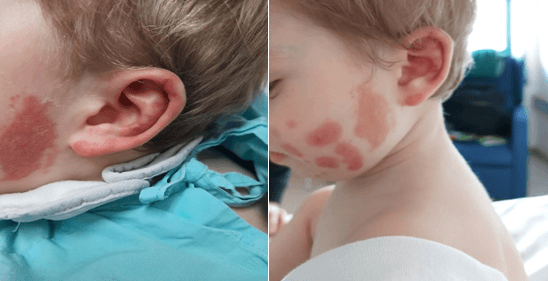A 14-month-old boy presented to the emergency department with an 8-day history of fever and oral aphthous lesions. On day 5 of illness, he was apyretic for almost 24 hours. On day 6, low-grade fever reappeared associated with nasal congestion, cough, diarrhea, facial rash and edema of both ears and amoxicillin/clavulanic acid was started given suspicion of cutaneous infection. After 48 hours, due to worsening of the rash and progressive peripheral edema, he was admitted to hospital for further investigation. No other symptoms nor history of suspicious exposures were found. Personal and family history were also unremarkable.
Physical examination showed purpuric lesions with a cockade pattern, localized to his face (cheeks and ears) and limbs. He also had significant non-pitting edema of the auricles and extremities. Multiplex PCR respiratory panel was positive for Adenovirus and Rhinorivus- Enterovirus. The remaining laboratory results and chest X-rays were normal.
The child was admitted considering the possibility of either acute hemorrhagic edema of infancy (AHEI) or post-infectious polymorphous erythema. During hospitalization, antibiotic therapy was suspended and a skin biopsy was carried out. Emollient cream and topical corticosteroid therapy were started with clinical improvement and he was discharged after 4 days. Clinical reassessment was carried out after 3 weeks, with resolution of the lesions and confirmed pathological diagnosis of AHEI.
Figure 1. Face and ear, day 8 and day 9.
 Figure 2.
Figure 2. Right arm, day 8 and day 9.
 Figure 3.
Figure 3. Left hand, day 8 and day 9.

What is Acute hemorrhagic edema of infancy?